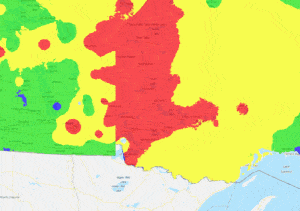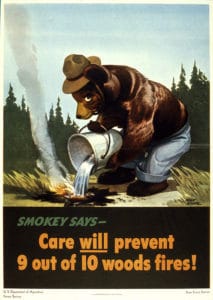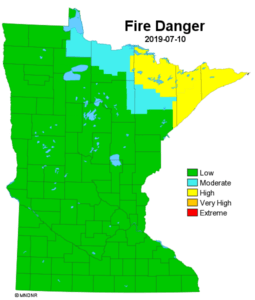
A summer of warm and dry weather has increased the risk of wildfire in the Minnesota-Ontario boreal forest. The risk recently became reality with a fire on Saganaga Lake, and prepared property-owners responded.
Most of the Canadian part of the region is under a low fire danger, after heightened risk earlier in the month. Much of the Arrowhead is under moderate to high danger, with the risk increasing from west to east.
On Monday, July 8, Cook County announced that most burning is banned. Authorities across the region are urging caution to prevent destructive fires. While fire is a natural and essential part of the forest, when uncontrolled, it has destroyed significant private property.
“Due to the prolonged period of minimal precipitation and forecast winds, burning permit activations for Cook County are restricted to Variances Only at this time,” the Cook County Sheriff’s Office stated.
There are no active fires in the Quetico-Superior region according to Ontario’s official map of activity across the province. Small blazes are burning between Wabikimi Provincial Park and the Manitoba border.

Citizen suppression on Saganaga
Also on Monday, cabin-owners on the Canadian side of Saganaga Lake put out a growing forest fire on an island nearby. Saganaga Lake spans the US-Canada border and is an entry point for the BWCAW. WTIP reports that the citizens were prepared with their own water pumps, hoses, and other gear, which they transported to the island by boat.
“It is believed that a smoldering piece of charcoal from a BBQ started the fire. There is one private residence on the island,” Matt Ritter, manager of Voyageur Canoe Outfitters and one of the individuals who responded to the fire, told the radio station. “At the time of the fire the property owners of the lone cabin on Browns Island had left. They had a BBQ the day before the fire sparked to life, meaning the coals were still hot from the previous day.”
With winds blowing at 10-15 miles per hour from the southwest, and the fire spreading from the ground into the crowns of pine trees, the citizen firefighters contained it before the flames could reach the nearby mainland. Facing high steep banks, and soil and rocks that became “very treacherous” after getting wet, responders were able to put the flames out. They spent several more hours soaking hot spots and making sure there would be no more flare ups in the wind that was still blowing.
Preparedness pays off
According to Jane Laurence of the Saganaga Ontario Association of Resort and Property Owners, the property-owners experienced the 2007 Ham Lake Fire, which burned 75,000 acres in the United States and Canada, and destroyed hundreds of private structures in both nations. After the Ham Lake Fire, Saganaga property-owners organized a “Sprinkler Brigade,” with equipment, sprinkler systems, protocols, and training.
“The responders included a 17 year old and an 80-something,” Laurence said. “Everyone had a role and did what they could.” The effort was led by Eric Johnson, who was one of the first to arrive. Neighbors were able to mobilize quickly thanks to marina radios, which are the main communication method on huge, island-studded lake. While an outhouse and shed on the island were destroyed by the fire, everyone emerged otherwise unscathed.
“There’s a feeling of quiet awe that given the unlimited number of ways this could have gone very badly . . . things weren’t much worse,” Laurence said.
‘Only you can prevent wildfires’

This year marks the 75th anniversary of the iconic mascot of fire prevention, Smokey Bear. While the popular character has helped Americans be more responsible with fire over the last seven decades, nearly 90 percent of wildfires are still caused by humans.
The Smokey Bear Pledge asks people to be careful with fire, never leave a fire unattended, put out fires cold, refrain from burning or using equipment when the fire danger is high, keep 15 feet between fires and flammable objects, and other best practices.
Smokey Bear’s Five Rules of Wildfire Prevention:
- Only you can prevent wildfires
- Always be careful with fire
- Never play with matches or lighters
- Always watch your campfire
- Make sure your campfire is completely out before leaving it
The Smokey Bear website includes how-to guides on preventing wildfires for campfires, burning debris, and operating equipment.
More information:
- Minnesota fire danger & current burning restrictions
- Minnesota Incident Command System (active fires)
- Ontario Forest Fire Info Map, Ministry of Natural Resources and Forestry (fire danger, restrictions, and active fires)
- Quetico fire ban information
- Firewise in Minnesota (for property-owners)
- U.S. Forest Service Wildland Fire
- Northland Fire Danger Monitor, National Weather Service


